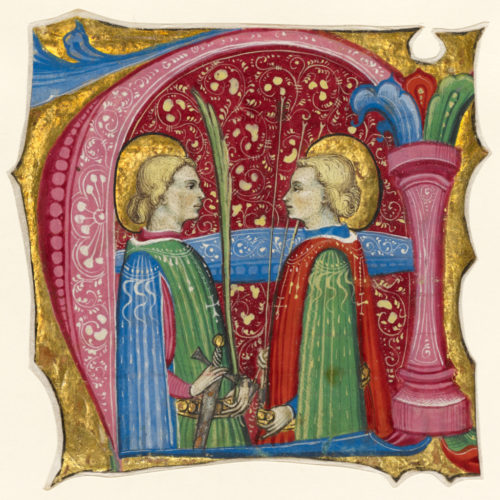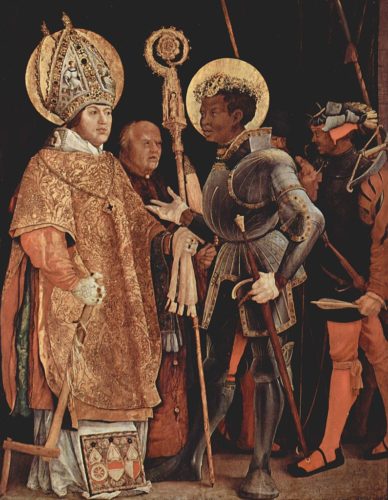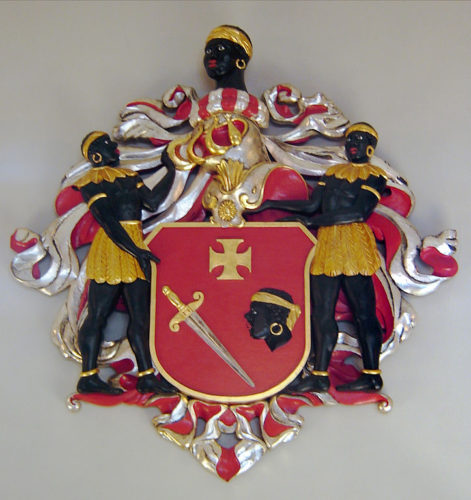Last Updated on January 7, 2024 by Kittredge Cherry

Maurice and Theofredus are third-century martyr-saints and soldiers of Thebes with a homosocial bond. They are shown as a same-sex pair in Renaissance art.
Maurice’s feast day is Sept. 22 in the Catholic tradition and Dec. 27 in the Orthodox tradition. Theofredus is honored in the Orthodox faith on Sept. 7.
The men gaze lovingly into each other’s eyes, hands almost touching, in a 15th-century Italian illuminated manuscript. The queer image is discussed in the article “Coming Out: Queer Erasure and Censorship from the Middle Ages to Modernity” by art historian Bryan C. Keene and curatorial assistant Rheagan Martin on the Getty Museum blog. They write:
“Saints Maurice and Theofredus—third-century CE soldiers of the Sacred Band of Thebes in North Africa and Christian martyr-saints—are among the faces of the past who had a homosocial relationship, involving friendship, fidelity, or a bond among members of the same sex (a bromance, so to speak, but on a deeper level). Some scholars have suggested that the oath of brotherhood taken by the Theban Legion was purely homosocial, but others hint that sexual encounters may have taken place between Maurice and his companions.”
For example, scholar James Neill states that “one has to wonder” about the possible homosexual relationships between paired saints, including Maurice and the martyrs of the Theban legion, in his book “The Origins and Role of Same-Sex Relations in Human Societies.”
Maurice was the commander of the Theban Legion, an entire Roman legion of 6,666 men. They converted together to Christianity and were brutally executed as a group in the year 286 in present-day Switzerland for the crime of refusing to kill fellow Christians.
Maurice or Mauritius, the most widely venerated member of the legion, is honored along with the rest on Sept. 22 in the Roman Catholic church and Dec. 27 in the Orthodox tradition. Theofredus, also known as Chiaffredo, escaped and was martyred later in Italy, hence he has a separate feast day on Sept. 7.
Maurice was often shown as a black knight
They look like white Europeans in the illuminated manuscript, but Maurice and Theofredus were both Egyptians. Artists often depicted Maurice as a black man, usually a black knight in shining armor. The name Maurice originally meant “the Moor” or “from Mauritania” (a Roman province in North Africa that includes present-day Morocco), so artists may have based his black skin on his name. More than 200 images of him are cataloged in the bilingual art book “The Black Saint Maurice / Mauritius: der heilige Mohr” by Gude Suckale-Redlefsen.

“The Meeting of Saints Erasmus and Maurice” by Matthias Grünewald, c. 1520 (Wikipedia)
An important example is “The Meeting of Saints Erasmus and Maurice” by the renowned German Renaissance painter Matthias Grünewald, who also painted the famous Isenheim Altarpiece. Maurice, on the right in a suit of armor, meets Erasmus, who is dressed in the gorgeous robes of an archbishop. The painting was intended to symbolize the power of the church on two continents.
Desiderius Erasmus, a 16th-century Dutch theologian-priest, is also considered a queer saint by some. “The primary basis of the claim is a series of passionate love letters he wrote to a young monk Servatius Roger, and allegations of improper advances made to the young Thomas Grey, later Marquis of Dorset, while Erasmus was employed as his tutor,” explains the Queering the Church blog. He lived more than 1,000 years after Maurice, so their meeting is imaginary. What would happen if these queer saints met?
Maurice is depicted as a black African man in the coat of arms of the Brotherhood of Blackheads, an association of unmarried merchants and foreigners that began in the 14th-century in present-day Estonia. Their patron saint was Maurice.

Coat of arms of the Brotherhood of Blackheads (Wikipedia)
Images like this are rightfully questioned in the era of Black Lives Matter, but the pair of black men gazing across at each other in the coat of arms can be seen as a visual counterpart and alternative to the lily-white version of Maurice and Theofredus in the illuminated manuscript. Could an affirmation of black gay holiness be hidden in this image?
Artwork of black saintliness as embodied by Saint Maurice began to die out in the mid-1500s. Unfortunately they were undermined by the development of the transatlantic slave trade of enslaved African people.
___
Top image credit:
“Initial A: Saints Maurice and Theofredus” about 1460 – 1480, tempera and gold leaf on parchment, by Frate Nebridio (Italian, died before 1503, active second half of the 15th century). Leaf: 11.5 × 11.5 cm (4 1/2 × 4 1/2 in.), Ms. 91 (2005.21), recto. Courtesy of the J. Paul Getty Museum, Los Angeles.
___
This post is part of the LGBTQ Saints series by Kittredge Cherry. Traditional and alternative saints, people in the Bible, LGBT and queer martyrs, authors, theologians, religious leaders, artists, deities and other figures of special interest to lesbian, gay, bisexual and transgender and queer (LGBTQ) people and our allies are covered.
This article was originally published on Q Spirit on Sept. 8, 2020, was expanded with new material over time, and was most recently checked on Sept. 5, 2023.
Copyright © Kittredge Cherry. All rights reserved.
Qspirit.net presents the Jesus in Love Blog on LGBTQ spirituality.







So you admit there’s no known romantic or sexual dimension to their relationship, and the only justification for the idea is a single painting that shows them staring blankly at each other, which some people have interpreted as a “gay stare” (as one gay activist put it)? Using terms like “homosocial bond” and “same-sex pair” are just misleading ways of saying that they associated with each other.